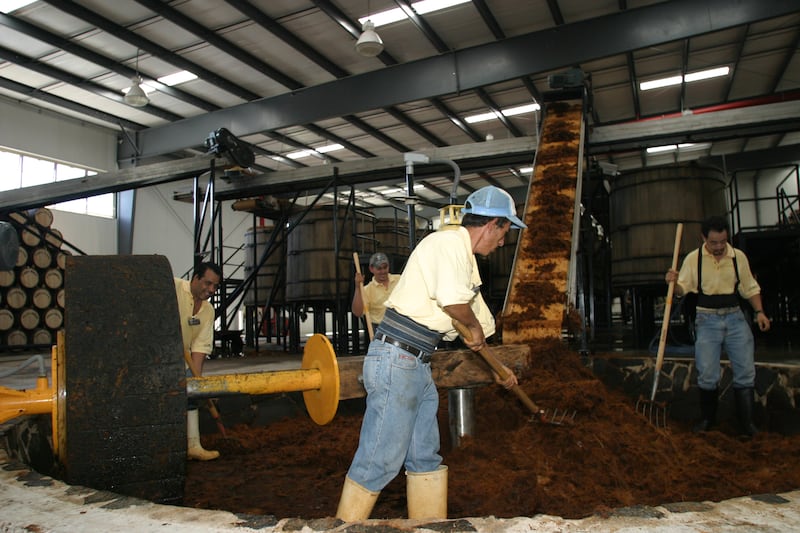Three hefty men labor to pull toward earth a 10-foot steel axle, which runs upward from a collar, around a post and through a hole in a two-ton wheel made of dark stone.
They exert themselves as if they’re trying to topple a giant. All the while, the stone is pulled in slow circles by a late 1970s John Deere tractor in a pit of volcanic stone, which is filled to calf-height with a damp, tawny-colored pulp. The men’s goal is to coax the stone’s angle from the oblique to the perpendicular, such that it can move to the outer ring of the pit and mash all the cooked agave. The team is just beginning this batch; the whole process will take about two hours.
“This is one of the most inefficient distilleries,” says Carlos Camerana, master distiller here at La Alteña distillery near the Mexican town of Arandas. In fact, his grandfather founded the distillery in 1937. They produce El Tesoro, Tapatio, and Tequila Ocho, among other agave spirits. (El Tesoro is the only one of their brands produced exclusively using this traditional method and is now owned by spirits conglomerate Beam Suntory.) “We like to do things the slow way,” he told me, perhaps superfluously, when I recently visited the facility as a guest of El Tesoro. But even at La Alteña time marches on and soon the men and the tractor will be replaced by a mechanized device to drag the stone wheel around and around.
The stone wheel is called a tahona, and the stone pit is a trapiche. While it sounds like a sequel to the Greek myth about Sisyphus, for generations this combo was about the only way to extract the juice from roasted agave plants, which could then be fermented and distilled into tequila. The wheel-and-pit were typically crafted from locally quarried volcanic stone, then pulled in circles by a burro or two. It was very local and inexpensive. Then technology leapt ahead, and distillers upgraded to the more efficient steel roller mills or diffusers. (The diffuser, which is rarely talked about but is widely used, is an industrial device that essentially cooks and shreds the agave at once, reducing the whole process from several days to one.)

Yet, tequila producers have lately been reverting to the OG tahona wheel, then crowing about their stubborn old-school methods in their marketing material. It’s like Ford announcing that they’ve brought back the Model T, or Apple announcing a new floppy disc drive.
Like El Tesoro, Fortaleza has long used a tahona in making tequila. San Matias now produces a 100-percent tahona tequila, as do Siete Leguas, Suerte, and Olmeca. Patrón may be the most prominent player with 10 tahona wheels, which is more than any other distiller. In 2014, it even released Roca (Spanish for “rock,” cleverly), a tequila made entirely of tahona-crushed agave. (Other Patrón products have always included some tahona-produced spirit, which is typically blended with roller-mill distillate. This is also the case at La Alteña, which has a roller mill used for brands other than El Tesoro.)
Touting tahona production makes sense in an era where both foodies and spirits aficionados often associate the primitive with the authentic, and embrace old-style approaches—pot-stilled, unfiltered, open-vat, wooden fermenters, and, in the case of Jamaican rum, the use of muck pits full of festering ooze.
And it’s more than just marketing. Anyone who has tasted fresh distillate produced by a tahona side-by-side with that from a roller mill knows instantly there’s a difference in flavor. But why?
Tequila producers tend to point out a simple fact when asked this question: the tahona process, despite the use of a two-ton stone, is actually a gentler way to extract juice than a roller miller, and, certainly, less aggressive than a diffuser.
“It’s been explained to me that when it’s shredded [as in a diffuser], fibers and skins are getting ripped apart and it’s releasing more bitter flavors than when gently pressed,” says Chantal Martineau, author of How the Gringos Stole Tequila and co-author of Finding Mezcal. “If you make pesto the way it’s supposed to be made—pounded in a mortar and pestle, it’s creamy and round. If you make it in blender it gets pulverized and has a bitter note.”
Antonio Rodriguez, Patrón Tequila’s director of production, agrees and points out that like the way the agave is roasted, “the tahona method is one of the most important factors for taste” in tequila production.
He adds that it’s not just the slow crushing action of the wheel itself that’s critical, but what happens afterwards. “At Patrón, the most important part of the tahona method is how we keep the remaining fiber for fermentation and distillation,” he says. “This creates the perfect environment to increase the congeners that are responsible for the complexity and sweetness of Patrón tahona tequilas. Roca tequilas exhibit more complexity and slightly less citrus, pepper and fruit than our core line.”
Carlos Camarena at El Tesoro echoes this point, noting that they add bags of agave pulp to both the fermentation tanks and into the pot stills for the first distillation run. He draws on a different food analogy. “It’s like orange juice,” he says. “To me the diffuser is like going to the store and buying a carton of juice. It’s officially orange juice, but it might have artificial color and flavor. That would be like the diffuser tequila. The roller mill is more like going somewhere they are squeezing oranges and you can get fresh orange juice—it could be of a very good quality. What is tahona? It’s like buying the orange, cutting the orange in half, and eating it directly with the juice and pulp in your mouth. There’s more flavor.”
Another factor possibly in play: microbes. Volcanic stones are semi-porous, hard to clean, and can serve as a home to microorganisms, which in theory could make their way into the fermentation process and influence flavors. Camarena doesn’t rule out microbial influence. “I don’t know,” he says. “We’re dealing with microorganisms floating around here, and nothing gets sterilized.”
“Fantasy,” argues Rodriguez. “Here at Patrón, we do an intensive cleaning process from batch to batch. Our yeast and production process are what is responsible for the flavors of Patrón tequila.”
The tahona itself needs to be replaced every decade or so—they simply wear down. One wonders: where does all that stone go? Only one place: into the tequila. While distillation will strip out the actual minerals, trace flavor elements may well survive the process. Camarena agrees that tahona-produced tequila might gain a touch of minerality as the stone wheel gradually erodes in its endless circling of the pit. After all, “it is not the same if you make a salsa with a blender as with a molcajete [a commonly used stone mortar and pestle],” he says. “You have the pulp and the fiber,” he says, “but it somehow has more flavor because of the stone itself.”
The combination of rounder, fuller flavors, and the imprimatur of authenticity, suggest that more producers may roll out their prehistoric stones in the coming years.
Four years ago, Carmen Villarreal, CEO of Casa San Matias Tequila in Los Altos de Jalisco, 60 miles east of Guadalajara, raided her brand’s museum in celebration of their 130th anniversary of making tequila. (The company is now part of Sazerac Company’s Gemini portfolio.) Her target? The long-disused tahona, which she pulled out of storage and promoted from display object to workhorse. It’s now used again to gradually crush roasted agave to make their San Matias Tahona Tequila.
“It’s back to work again,” says Villarreal.






